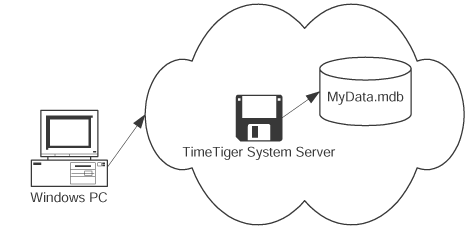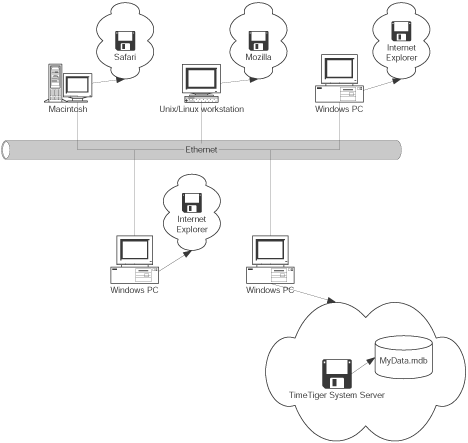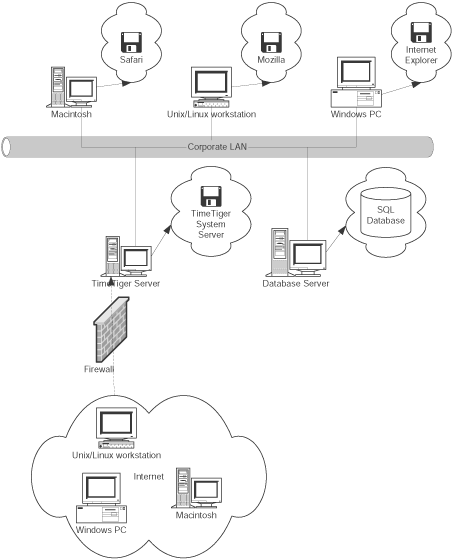Technical Overview and Architecture
The TimeTiger time and project tracking system has been designed to meet the needs of organizations from 1 to over 1,000 individual users. This document describes the components that make up TimeTiger and how these components work together to form a system. Various deployment approaches are illustrated, for installations ranging from a single-user desktop configuration to a multi-server, fault tolerant set-up suitable for 1,000 or more time loggers.
If you have questions about the specific needs of your organization, please e-mail us at sales@indigo1.com.
How TimeTiger Works
At the core of the TimeTiger system is the TimeTiger System Server. The TimeTiger System Server is a web server that hosts one or more TimeTiger applications, each of which is connected to a TimeTiger database. The TimeTiger database houses all the time log data, system configuration and user data required for the entire system. As of TimeTiger 2, the TimeTiger database can be stored in Microsoft Access 2000 format or on a Microsoft SQL Server. The TimeTiger database is open-architecture, meaning you are able to use third-party reporting and analysis tools to look at TimeTiger data, and even create your own applications that interface with the TimeTiger system. The TimeTiger database resides in a single location on your PC (for single-user installations) or network (for multi-user installations).
You install the TimeTiger System Server on a single computer (running Windows XP, 2000 or 2003), and then access the TimeTiger application using a web browser from the same PC or any other PC connected to your network.
For single-user installations, the TimeTiger application, database, and web browser can all reside on the same PC.
A single-user TimeTiger system

The single-user installation is the simplest TimeTiger configuration we support. A single PC houses the TimeTiger System Server, which has been used to create a single TimeTiger application connected to an Access 2000 format TimeTiger database. Note that owning Microsoft Access 2000 is not required to use the system: everything you need is already built-in to TimeTiger.
A Peer-to-Peer TimeTiger system

For small workgroups using a peer-to-peer network (such as Microsoft Windows 95/98/ME networking) multiple workstations can connect to a single TimeTiger System Server located on one of the machines on the network. This machine must be on at all times so that the other machines can connect to and use the TimeTiger system. This configuration is not recommended for workgroups larger than 10 machines.
A LAN-based TimeTiger system

For larger departmental or organization-wide deployments, the TimeTiger System Server should be deployed on a network server machine and the database should reside on a network file server (for Access 2000 databases), or a Microsoft SQL Server (for SQL Server databases, shown here). All LAN workstations access TimeTiger using a standard web browser. Optionally, you can allow Internet or WAN users to connect to the same TimeTiger System Server through your corporate firewall. This configuration is recommended for up to 150 users (using an Access format database) or 1,000+ users (using a SQL Server database).
An enterprise TimeTiger system
For enterprise-wide deployments where scalability, performance and reliability are critical, component redundancy and load balancing can be introduced using the facilities already available in Microsoft Windows Server and Microsoft SQL Server. By clustering the various servers involved and implementing SQL Server replication and Windows Advanced Server cascading failover, TimeTiger can reliably support your entire enterprise of 1,000+ users.
For large installations such as this we recommend you take advantage of the skills provided by our professional services team to help design and configure your deployment. We can help you architect the perfect tracking solution for your entire organization. For more information,
Microsoft Access or SQL Server?
TimeTiger gives you the option of using a database in Microsoft Access 2000 format or a Microsoft SQL Server database. When choosing which of these two platforms to deploy on, bear the following considerations in mind:
- Although you do not require your own copy of Microsoft Access to use an Access 2000 format database with TimeTiger, you do require your own Microsoft SQL Server to use a SQL Server format database.
- Databases in both formats require some administration. An Access 2000 database must be regularly compacted to preserve performance and data integrity. A SQL Server should be managed by a qualified database administrator to ensure the security, safety, and performance of your application.
- There is no hard user limit imposed on either database format. Performance and reliability are the chief considerations in deciding to go with SQL Server, especially for installations of over 150 users.
- You can always change your mind. TimeTiger can seamlessly convert your data from Access 2000 to SQL Server format, or vice-versa.
If you have any questions related to purchasing TimeTiger, please e-mail sales@indigo1.com.
See What TimeTiger
Can Do For You!
Begin Your Free
30-Day Trial Today!